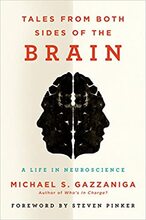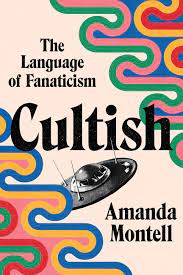Author: Michael S. Gazzaniga
ISBN-10: 0062228803
ISBN-13: 978-0062228802
APA Style Citation
Gazzaniga, M.S. (2015). Tales from both sides of the brain: A life in neuroscience. HarperCollins.
Buy This Book
https://www.amazon.com/Tales-Both-Sides-Brain-Neuroscience/dp/0062228803
| tales_from_both_sides_activity.pdf |
Michael Gazzaniga stated, “Science results from a profoundly social process.” Tales From Both Sides of the Brain: A Life in Neuroscience is an autobiography about his research, but also the friendships, opportunities, and professional moves Dr. Gazzaniga made as he changed how we think of the brain. He shares his story of how scientists are a blend of both scientific and personal life experiences. The book focuses on six split-brain patients that helped change much of what is known in cognitive neuroscience. As he quickly points out, while much of scientific work is routine, the discoveries are still exciting! His story is one with a beginning and middle, but no end.
Gazzaniga’s early days started at Caltech, under Dr. Roger Sperry. While Gazzaniga was the novice, Sperry was the pro in split-brain research. Most of Sperry’s work was done with cats, but he was a great surgeon and fiercely competitive. Under Sperry’s guidance, Gazzaniga moved from studying animals to human patients in 1962. Their first human patient was William (Bill) Jenkins. They had to figure out the basics of how to test someone with a split brain. The left half of the body sends MOST information about touch to the right hemisphere. However, the mere presence or absence of being touched goes to both hemispheres. They used the visual system because it was simple and highly lateralized. The two had their differences, but when Sperry won the Nobel Prize in 1981, Gazzaniga wrote an appreciation article for him published in Science magazine.
Research shows that the left brain specializes in speech and language processes, while the right brain specializes in visual tasks. However, many split-brain patients used external self-cueing to help unify some of their disconnected information. Most eventually gained control of their ipsilateral (same-side) arm. It was this dual control of both the contralateral (opposite-side) and ipsilateral (same-side) that made it hard to evaluate the specialization of the left and right brains. Gazzaniga had no idea how rich split-brain research would become until more cases were added to the pool, and these newer cases were complicating. Like an old married couple…subtle cueing between the two is going on all the time. Similarly, half of the brain is living next to the other half and the ability of split-brain patients to look as if they were integrated develops over time. The two mental systems were being forced to share the same resources, and somehow, they worked it out. This made it hard to do the research.
Gazzaniga’s professional career involved many moves. Wanting his own lab, he moved to the University of California, Santa Barbara. He was both a teacher and researcher, and quickly moved up to department chair. It was here that he began his closest lifelong friendship with David Premack. During this time, he also led his first interdisciplinary forum. Dr. Gazzaniga wanted to be associated with a medical center to see a wider range of neurological patients and with a little east coast fever, he moved to New York. There he set up a weekly lunch with Leon Festinger for the next 20 years. It was his friendships with Premack and Festinger that helped him continually reassess his and Sperry’s claim that there were two minds in one brain. Once again, Gazzaniga was on the move. This time to Dartmouth. His graduate student was Joseph LeDoux and they created a mobile lab to go to the patients. It was a time of new patients, discoveries, and insights. It was discovered that the left brain was an interpreter. When the left brain had no clue what was going on, it would try to explain it away. Gazzaniga moved again to Cornell University Medical College and convinced LeDoux to join him. Together they continued to complete critical experiments to understand the brain. It was in New York that Gazzaniga met up with George Miller. While he found him and his office intimidating, they quickly became friends and together launched cognitive neuroscience, the study of how the brain creates the mind. An important part of Gazzaniga’s academic life was holding special meetings in special places. He led an annual, weeklong conference. When he moved back to Dartmouth, he brought with the Cognitive Neuroscience Institute and created the Journal of Cognitive Neuroscience. But the west coast was calling and Gazzaniga moved to the University of California, Davis. His patients traveled to him and he did a PBS special hosted by Alan Alda. Dr. Gazzaniga continued his training of the next generation by holding an annual conference, and publishing their work in one large reference book. He also helped with efforts to build a database for brain imaging experiments done around the world. He requested researchers submit data in order to be published in the Journal of Cognitive Neuroscience. It ended up not working out, but was a great step for more public communication.
While science has always been important to Gazzaniga, he is also interested in many other issues. Early on as a graduate student, he hosted a political debate on campus that garnered much attention. He credits this first experience to his ability to organize future scientific meetings and help translate complicated topics for public communication. Over the next several decades, Gazzaniga and his second wife, Charlotte, hosted somewhere around 300 dinner parties. These social gatherings played a significant role in the field of cognitive neuroscience. He also talked his friend, the political commentator, into interviewing his friends (e.g., B.F. Skinner, Premack, Festinger) on his show Firing Line. He became interested in public affairs and wrote on the problem of crime prevention. Gazzaniga also served on the President’s Council of Bioethics and worked to help answer the embryo question- when human life begins? Pursuing diverse issues has always been important to him.
Gazzaniga’s story is one of science, people, and experiences. He concludes with reminding the reader the story has not ended. While some of the easy, low-hanging fruit, has been picked in neuroscience, there are still more answers to find.
Other Related Resources
Author's Website- University of California, Santa Barbara
https://people.psych.ucsb.edu/gazzaniga/michael/
Lessons Learned from a Life in Science
https://www.psychologicalscience.org/observer/lessons-learned-from-a-life-in-science
Psychological Figures and Concepts
Paul Broca
Noam Chomsky
Leon Festinger
Clever Hans
David Hubel
Daniel Kahneman
Karl Lashley
Joseph LeDoux
Kurt Lewin
Margaret Mead
George Miller
Daniel Pinker
David Premack
Stanley Schachter
B.F. Skinner
Roger Sperry
Endel Tulving
Robert Zajonc
Attention
Basic research
Bioethics
Blindsight
Brain plasticity
Cognitive dissonance
Cognitive neuroscience
Confabulation
Contralateral vs. ipsilateral control
Corpus callosum
EEG
Embryo
Episodic memory
fMRI
Global aphasia
IRB
Korsakoff’s syndrome
Lateral ventricles
MRI
Parallel processes
Semantic memory
Split-brain research
Synesthesia
Syntax
Theory of mind
Top-down vs. bottom-up processing
WAIS


 RSS Feed
RSS Feed